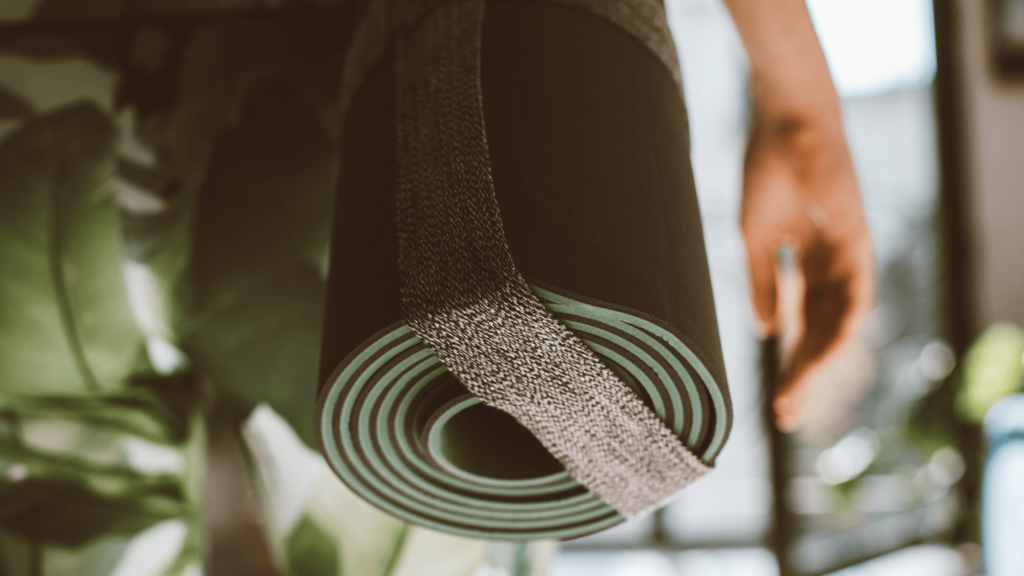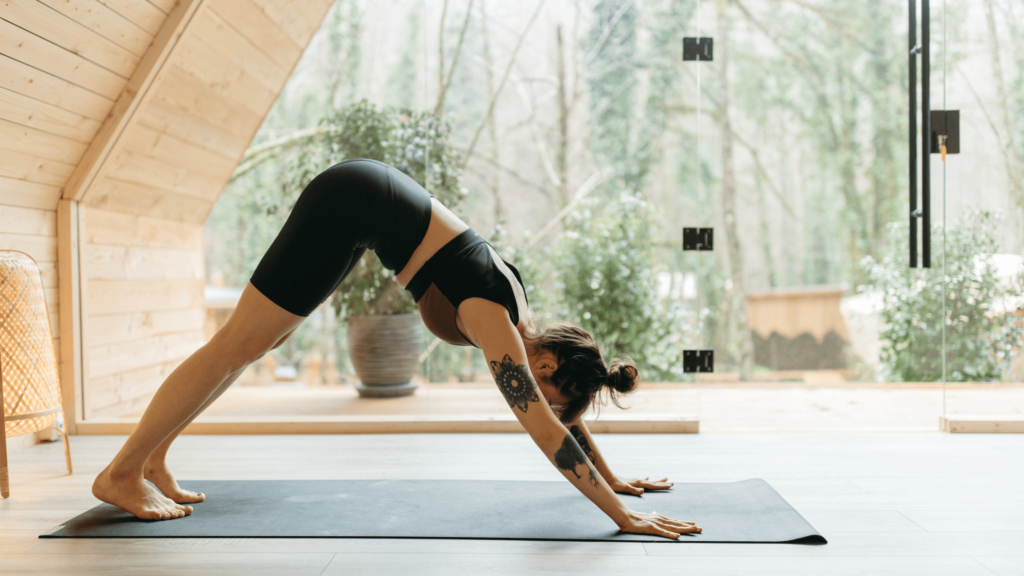In this article, you’ll discover the top 10 best yoga mat suited for every practice, whether you’re a beginner or a seasoned yogi. We will cover the unique features, pros and cons, and user experiences of each mat to help you make an informed decision. Additionally, we’ll provide tips on how to choose the right mat based on your individual needs and preferences.
A great yoga mat isn’t just a surface to practice on; it’s your foundation for stability, comfort, and alignment, transforming your yoga sessions into fulfilling and empowering experiences.
Table of Contents
Criteria For Choosing The Best Yoga Mat

Material
- PVC (Polyvinyl Chloride)
- Pros: Durable, sticky surface provides excellent grip.
- Cons: Not eco-friendly, can contain harmful chemicals.
- TPE (Thermoplastic Elastomer)
- Pros: Lightweight, eco-friendlier than PVC, good grip.
- Cons: Less durable than PVC.
- Natural Rubber
- Pros: Eco-friendly, excellent grip, biodegradable.
- Cons: Heavier, can have a distinct smell.
Thickness
- Thin Mats (1/16″ – 1/8″)
- Pros: Provides stability, ideal for travel.
- Cons: Less cushioning, may be uncomfortable for joints.
- Standard Mats (1/8″ – 1/4″)
- Pros: Balanced comfort and stability, suitable for most practices.
- Cons: Might not provide enough cushioning for sensitive joints.
- Thick Mats (1/4″ – 1/2″)
- Pros: Extra cushioning for joint protection.
- Cons: Less stability for balance poses.
Texture
- Smooth Texture
- Pros: Soft feel, good for flowing movements.
- Cons: Can become slippery with sweat.
- Textured Surface
- Pros: Enhanced grip, prevents slipping.
- Cons: Can be rough on the skin.
Durability
- Importance: Ensures longevity and consistent performance over time.
- Factors: Material quality, frequency of use, maintenance requirements.
Eco-Friendliness
- Sustainable Options: Natural rubber, cork, jute.
- Non-Toxic: Free from harmful chemicals like phthalates and latex.
Portability
- Lightweight Mats: Easier to carry, ideal for travel.
- Foldable or Rollable: Compact storage and transport.
- Travel-Friendly Features: Include carrying straps or bags.
Suggested: 7 Best Energy Drink For Workout!
Top 10 Best Yoga Mat for Every Practice

1. Manduka Pro Yoga Mat
- Material: PVC
- Thickness: 6mm
- Texture: Smooth with a closed-cell surface
- Durability: Extremely durable, lifetime guarantee
- Eco-Friendliness: OEKO-TEX certified, free from harmful substances
- Portability: Heavy, best for home practice
- User Ratings: 4.8/5
2. Liforme Yoga Mat
- Material: Natural rubber and eco-polyurethane
- Thickness: 4.2mm
- Texture: Textured surface for superior grip
- Durability: High durability, biodegradable materials
- Eco-Friendliness: Biodegradable, non-toxic materials
- Portability: Includes carrying bag
- User Ratings: 4.7/5
3. Jade Yoga Harmony Mat
- Material: Natural rubber
- Thickness: 5mm
- Texture: Open-cell surface for excellent grip
- Durability: High durability, environmentally conscious production
- Eco-Friendliness: Made with natural rubber, non-toxic
- Portability: Medium weight
- User Ratings: 4.6/5
Download Your Weekly Meal Plan Template: Your Go To Meal Prep
4. Gaiam Yoga Mat
- Material: PVC
- Thickness: 6mm
- Texture: Sticky surface for enhanced grip
- Durability: Moderate durability, affordable price
- Eco-Friendliness: Free from harmful chemicals
- Portability: Lightweight, easy to carry
- User Ratings: 4.5/5
5. Lululemon The Reversible Mat
- Material: Polyurethane and natural rubber
- Thickness: 5mm
- Texture: Dual-texture surface for versatility
- Durability: High durability, designed for heavy use
- Eco-Friendliness: FSC-certified rubber
- Portability: Medium weight
- User Ratings: 4.6/5
6. prAna E.C.O. Yoga Mat
- Material: Thermoplastic elastomer (TPE)
- Thickness: 5mm
- Texture: Textured surface for grip
- Durability: Good durability, lightweight
- Eco-Friendliness: 100% recyclable, non-toxic
- Portability: Very lightweight, travel-friendly
- User Ratings: 4.4/5
7. Yogi Bare Paws Extreme Grip Yoga Exercise Mat
- Material: Natural rubber and eco-polyurethane
- Thickness: 4mm
- Texture: Extreme grip surface
- Durability: High durability, designed for intense practice
- Eco-Friendliness: Biodegradable, non-toxic
- Portability: Medium weight, includes carrying strap
- User Ratings: 4.7/5
8. Hugger Mugger Para Rubber Yoga Mat
- Material: Natural rubber
- Thickness: 6.35mm
- Texture: Non-slip surface
- Durability: Very durable, long-lasting
- Eco-Friendliness: Made from sustainable materials
- Portability: Heavier side, better for home use
- User Ratings: 4.6/5
9. SugaMat Recycled Wetsuit Yoga Mat
- Material: Recycled wetsuits
- Thickness: 5mm
- Texture: Grippy surface
- Durability: High durability, unique material
- Eco-Friendliness: 100% recycled materials
- Portability: Moderate weight
- User Ratings: 4.5/5
10. BalanceFrom GoYoga All-Purpose Yoga Mat
- Material: High-density foam
- Thickness: 6mm
- Texture: Non-slip surface
- Durability: Moderate durability, very affordable
- Eco-Friendliness: Free from harmful chemicals
- Portability: Lightweight, includes carrying strap
- User Ratings: 4.4/5
Attention! Mayaro Virus: Are You at Risk?
Tips For Maintaining Your Yoga Mat

Cleaning and Storage
- Regular Cleaning:
- Light Cleaning: Use a damp cloth with a mild soap solution to wipe down your mat after each use. This helps remove sweat and dirt.
- Deep Cleaning: Every month or so, give your mat a more thorough clean by soaking it in a bathtub with a gentle detergent, then rinse thoroughly with water.
- Natural Cleaners: Consider using a homemade cleaning solution with water, vinegar, and a few drops of essential oil to keep your mat fresh and free of harmful chemicals.
- Drying:
- Air Dry: Always let your mat air dry completely before rolling it up. Hang it over a drying rack or shower rod, but avoid direct sunlight, as it can degrade the material over time.
- Avoid Heat: Do not use a dryer or leave your mat near heat sources like radiators, which can cause it to warp or degrade.
- Storage:
- Rolling: Roll your mat with the practice side out to keep it flat when you unroll it.
- Avoid Tight Rolls: Don’t roll your mat too tightly, as this can cause creases and damage over time.
- Storage Location: Use a yoga mat bag or strap to keep it secure and protect it from dust and dirt.

Maintenance
- Maintaining Grip:
- Mat Break-In: New mats can be slippery. Break in your mat by practicing frequently. You can also sprinkle a bit of salt on the mat and rub it in with a damp cloth to improve the grip.
- Grip Sprays: Use a mat-specific grip spray or a mixture of water and a few drops of essential oils to enhance grip during practice.
- Repairing Minor Damages:
- Small Tears: If your mat has small tears or nicks, consider using a small amount of adhesive or mat repair tape to patch them up.
- Frayed Edges: For mats with fabric or open-cell surfaces, trim any frayed edges with scissors to prevent further damage.
- Preventing Wear and Tear:
- Alternate Sides: If your mat is double-sided, alternate which side you use to practice to distribute wear evenly.
- Avoid Sharp Objects: Keep your mat away from sharp objects and surfaces that could puncture or tear it.
- Proper Use: Avoid using shoes on your mat and try not to drag it across rough surfaces.
Final Words
Selecting the perfect yoga mat is vital for enhancing your practice, ensuring comfort, and maintaining stability. By considering the material, thickness, texture, durability, eco-friendliness, and portability, you can find a mat that aligns with your specific needs and preferences.
Additionally, proper maintenance and care, including regular cleaning, appropriate storage, and timely repairs, will extend the life of your yoga mat and keep it in optimal condition. Investing in a good yoga mat and maintaining it well ensures a more fulfilling, effective, and enjoyable yoga practice. With the right mat, you can truly transform your practice and achieve your fitness and wellness goals.
Related Articles
- Transform Your Life With Somatic Yoga!
- Why Try Naked Yoga? Embracing Body Positivity and Self-Acceptance!
Further Reading
- Books:
- “The Yoga Bible“ by Christina Brown
- “Light on Yoga“ by B.K.S. Iyengar
- Articles:








